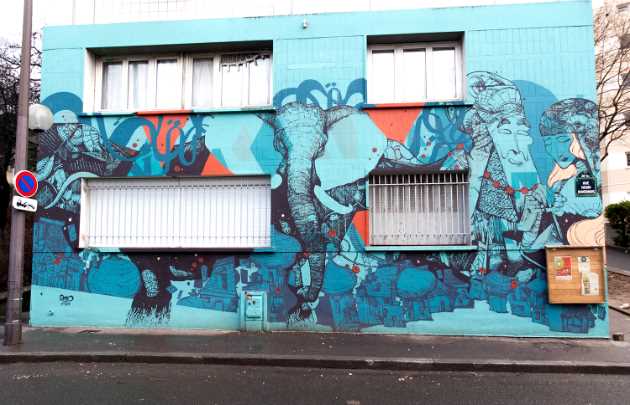Street art has become a prominent form of artistic expression in cities around the world. Originally considered an act of vandalism, street art has evolved into a legitimate art form, admired and appreciated by many. Its unique and often thought-provoking designs can be found on walls, buildings, and sidewalks, transforming urban landscapes into vibrant and dynamic galleries.
One of the defining features of street art is its ability to capture the spirit of a community and convey powerful messages. Artists use various techniques, such as stenciling, graffiti, and mural painting, to create visually stunning and socially relevant artworks. These designs often reflect the culture, history, and social issues of the community they are created in.
Street art designs are not limited by traditional artistic boundaries. Artists are free to experiment with different styles, colors, and mediums, resulting in a wide range of creative and innovative artworks. From colorful and abstract compositions to detailed and realistic portraits, street art offers something for everyone, appealing to both art enthusiasts and the general public.
Street art designs also have the ability to transform forgotten or neglected spaces into vibrant and lively areas. Abandoned buildings, empty walls, and back alleys become canvases for artists to showcase their talent, revitalizing these spaces and adding a sense of beauty and intrigue to the urban environment.
Expression through Art
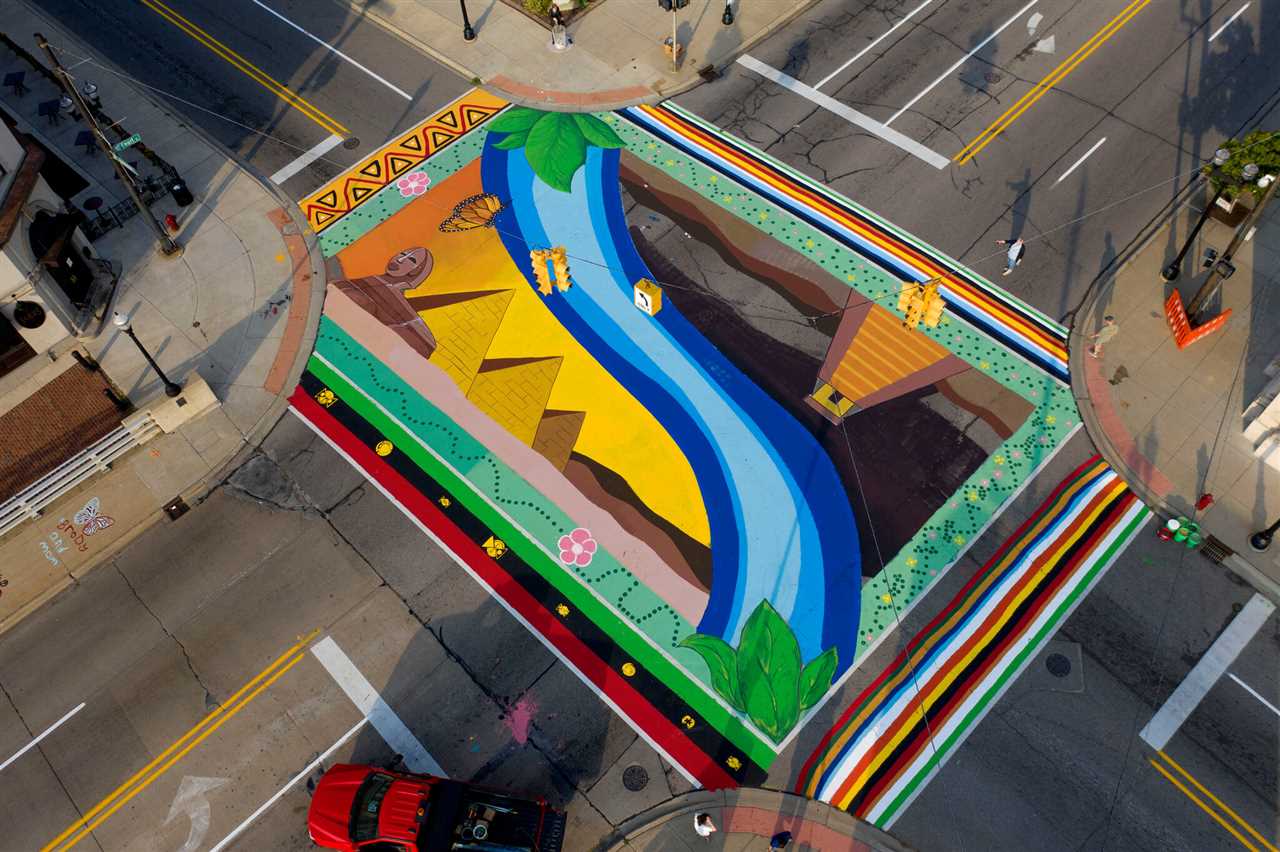
Street art is a powerful form of self-expression that allows artists to convey emotions, thoughts, and messages to a wide audience. Through their art, street artists can inspire, provoke, and challenge societal norms.
One of the key features of street art is its accessibility. Unlike traditional art forms that are often confined to galleries or museums, street art is out in the open for everyone to see. This accessibility allows artists to reach a diverse range of people and engage them in important conversations.
Street art can tackle a variety of topics, from political and social issues to personal stories and reflections. Artists use different techniques and styles to create visually striking pieces that capture attention and make a lasting impact.
One common theme in street art is social activism. Many artists use their work to raise awareness about pressing social issues such as inequality, discrimination, and environmental degradation. By creating thought-provoking and visually appealing pieces, street artists contribute to public discourse and encourage viewers to question the status quo.
Furthermore, street art allows for the expression of personal experiences and emotions. Artists often use their work as a form of therapy, allowing them to process and communicate their thoughts and feelings. This authenticity and vulnerability shine through in their art and resonate with viewers on a deep level.
Street art also has the power to transform urban spaces and create a sense of community. By turning empty walls and buildings into vibrant canvases, artists breathe new life into neglected areas and inspire a sense of pride and ownership among residents. Street art can bring people together, forging connections and fostering a shared sense of identity.
History of Street Art

Street art has a rich and diverse history that dates back several decades. Originally, street art was primarily associated with graffiti and tagging, which was often seen as vandalism. However, over the years, street art has evolved into a respected and influential art form.
The origins of street art can be traced back to the 1960s and 1970s when youth culture movements, such as hip-hop and punk, were gaining popularity. During this time, graffiti emerged as a form of self-expression and a way for marginalized communities to reclaim public spaces.
One of the key figures in the history of street art is an American artist named Keith Haring. Haring’s iconic and recognizable style, characterized by bold lines and vibrant colors, brought street art into the mainstream art world. Haring used public spaces, such as subways and walls, as his canvas to communicate social and political messages.
In the 1980s, street art gained further recognition with the emergence of artists like Jean-Michel Basquiat and Banksy. Basquiat’s unique blend of graffiti, street art, and fine art made him a prominent figure in the art world. Banksy, on the other hand, is known for his anonymous street art and provocative themes, which often challenge political and societal norms.
During the 1990s and early 2000s, street art continued to evolve with the introduction of stencil art and wheatpasting. Stencil art, popularized by artists like Shepard Fairey (known for his “Obey” campaign), involved using stencils to create detailed and intricate designs. Wheatpasting, on the other hand, was a technique used by artists like Swoon to paste paper artwork onto surfaces in public spaces.
Today, street art has become a global phenomenon, with artists from all over the world creating murals and installations in cities across the globe. Street art festivals and exhibitions have also become more common, providing artists with opportunities to showcase their work to a wider audience.
Overall, the history of street art is one that reflects the ability of art to transcend boundaries and spark conversations. From its origins as a form of rebellion and self-expression to its current status as a recognized art form, street art continues to push boundaries, challenge norms, and make a lasting impact on the art world.
Urban Art Movement
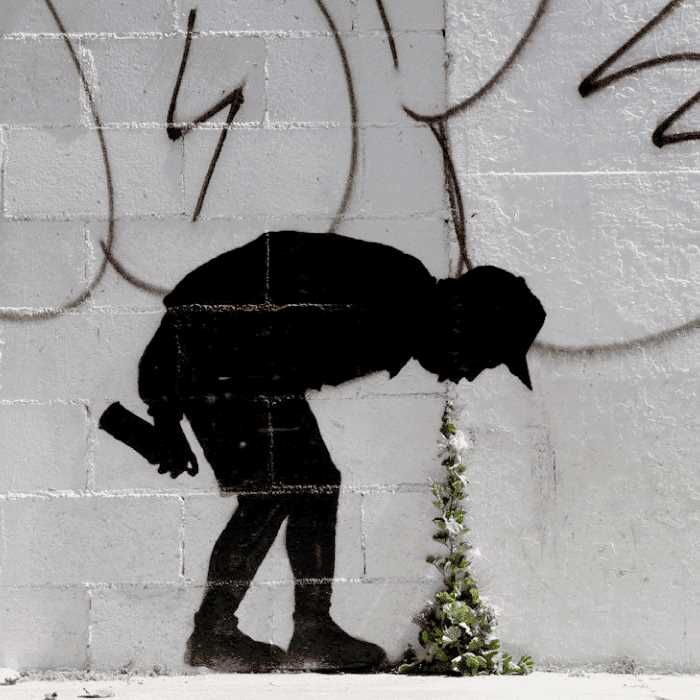
The urban art movement is a cultural phenomenon that has gained significant popularity in recent years. It refers to the artistic expression that takes place in public spaces, such as streets, buildings, and other urban areas. Street artists use various techniques and mediums to create their works, including graffiti, stencils, murals, and installations.
This form of art is often seen as a way for artists to challenge the traditional art world and make their work more accessible to the general public. It allows them to bypass the barriers and gatekeepers of the art establishment, bringing their creations directly to the streets where anyone can appreciate and interact with them.
One of the defining characteristics of the urban art movement is its temporary nature. Many street art pieces are ephemeral, lasting only for a short period of time before they are painted over, removed, or destroyed. This transitory quality adds to the allure and mystique of street art, attracting enthusiasts who appreciate the impermanence and unpredictability of the medium.
The urban art movement has also been associated with activism and social commentary. Many street artists use their work to raise awareness about political issues, social injustices, and urban decay. Through their art, they aim to spark conversations, provoke thought, and challenge the status quo.
However, the urban art movement has not been without controversy. Some view street art as vandalism and a form of illegal activity, leading to clashes with authorities and debates about its legitimacy. Nonetheless, street art continues to thrive and evolve, with artists pushing the boundaries of creativity and finding new ways to engage with the urban landscape.
Creative Street Art Designs

Street art is a form of artistic expression that is often found in urban areas and public spaces. It has grown in popularity over the years and has become a way for artists to express themselves and make a statement. Creative street art designs can be found all over the world, ranging from colorful graffiti to large-scale murals. These designs can transform a dull and mundane space into a vibrant and captivating work of art.
Exploring Different Styles
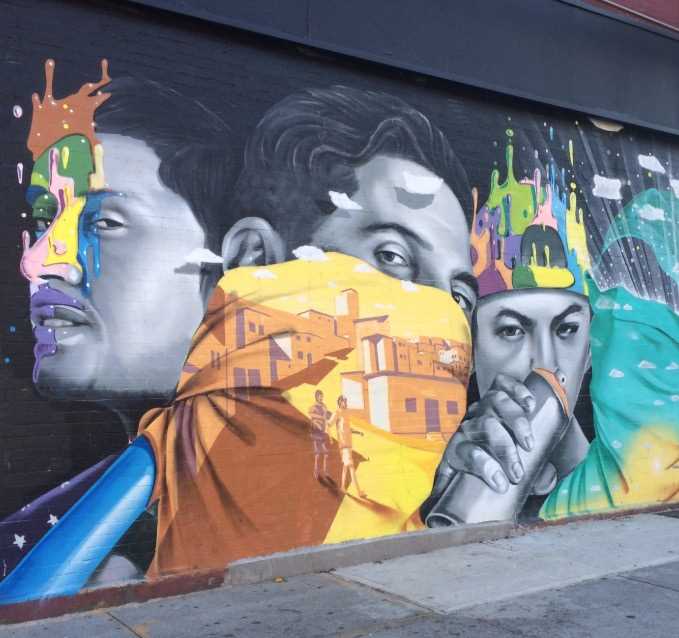
There are various styles of street art that artists use to create their designs. One popular style is stenciling, where artists will create a stencil of their design and then spray paint it onto a wall or surface. This allows for quick and precise creation of the artwork.
Another style is wheatpasting, where artists will create posters or images and then adhere them to a surface using a wheat-based paste. This style allows for more flexibility and can be easily applied and removed.
Making a Statement
Street art is often used to make a political or social statement. Artists will create designs that address issues such as inequality, environmental preservation, or human rights. By creating these designs in public spaces, artists hope to inspire conversation and provoke thought.
Street art can also be a way for artists to reclaim and beautify abandoned or neglected spaces. By transforming these spaces into works of art, artists can bring attention to areas that may have been overlooked or forgotten.
Street art is a form of art that pushes boundaries and challenges traditional artistic norms. It allows artists to use public spaces as their canvas, creating thought-provoking and visually stunning designs that can be admired by all who pass by.
Whether it’s a mural on the side of a building or a small sticker on a lamppost, street art has the power to spark creativity and inspire change. The next time you walk through a city, take a moment to appreciate the creativity and beauty of the street art around you.
Colors as a form of Expression
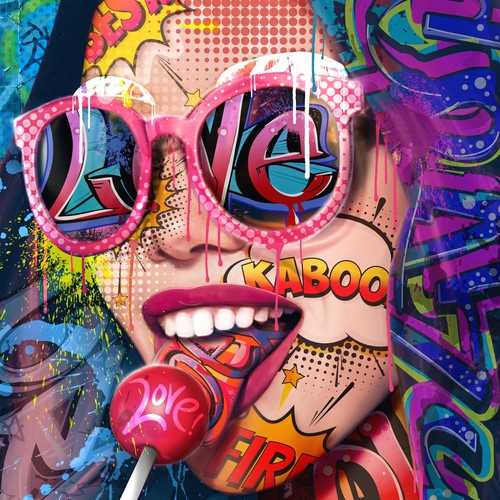
Street art designs are not only characterized by their bold and captivating imagery, but also by their vibrant and dynamic use of colors. Colors play a crucial role in the overall impact and message of street art, serving as a form of expression for both the artist and the audience.
Artists often use colors strategically to evoke certain emotions or convey specific meanings. For example, bold and bright colors such as red, orange, and yellow are commonly used to create a sense of energy, passion, and excitement. These colors can grab attention and evoke strong emotions, making the artwork stand out in its urban environment.
In contrast, cool colors like blue, green, and purple are often used to create a calming or soothing effect. These colors can evoke a sense of tranquility or serenity, providing a contrast to the hustle and bustle of the city streets. They can also represent themes of nature and harmony, bringing a sense of balance to the urban landscape.
The use of monochromatic or limited color palettes is also a common technique in street art. By using a limited range of colors, artists can create a sense of cohesion and harmony within their designs. This approach can also draw attention to specific elements or details within the artwork, allowing the viewer to focus on the intended message or story being told.
Colors in street art can also be used to communicate cultural or social messages. For example, certain colors may be associated with specific social movements or causes, such as the use of pink to represent gender equality or purple to symbolize LGBTQ+ rights. By incorporating these colors into their artwork, artists can provoke thought and spark conversations about important social issues.
Overall, the use of colors in street art designs goes beyond mere aesthetics. It serves as a powerful tool for artists to express themselves, evoke emotions, and communicate messages to the public. Whether it’s through bold and vibrant colors or subtle and muted tones, street art continues to push the boundaries of artistic expression and captivate audiences worldwide.
Graffiti as Street Art

Graffiti has long been associated with vandalism and illegal activity, but in recent years it has gained recognition as a legitimate form of artistic expression. Street art, including graffiti, has become an important part of contemporary culture, adding color and vibrancy to our cities.
The History of Graffiti
Graffiti can be traced back to ancient times, with examples of writing and drawings found on walls in ancient Rome and Greece. In modern times, graffiti emerged as a form of expression in the 1960s and 1970s, primarily in urban areas. It was often used as a way for marginalized communities to make their voices heard.
Unfortunately, graffiti has been stigmatized by society, leading to laws and regulations against it. However, many artists have found ways to use graffiti in a positive and legal way, creating stunning works of art that enhance public spaces.
Street Art vs. Vandalism
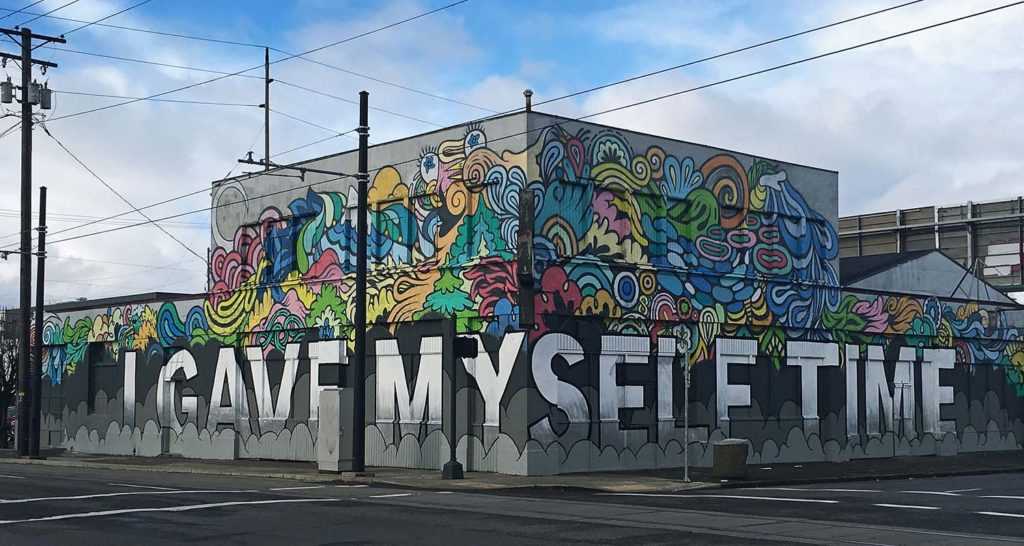
There is a fine line between street art and vandalism, and it is often a matter of perspective. While some may see graffiti as destructive and unsightly, others view it as a form of artistic expression.
Street art can transform mundane walls and buildings into works of art, brightening up neighborhoods and bringing communities together. It can also serve as a platform for social and political commentary, addressing important issues such as inequality, injustice, and environmental concerns.
However, there are cases where graffiti crosses the line into vandalism, such as tagging private property without permission or defacing public monuments. It is important for artists to respect the boundaries and regulations set by society, while still pushing the boundaries of what is considered acceptable art.
The Impact of Graffiti

Street art has the power to provoke thought, spark conversations, and challenge the status quo. It can inspire creativity and imagination, making our cities more vibrant and exciting places to live. Some cities have embraced street art, creating designated spaces where artists can legally express themselves and showcase their talent.
Additionally, street art can attract tourists and bring economic benefits to local communities. Murals and graffiti tours have become popular attractions in many cities around the world, drawing visitors who want to explore the unique street art culture and support local artists.
Using Walls as Canvas
Street artists use various techniques and materials to create their works. Spray paint is commonly used due to its quick-drying nature and vibrant colors. Stencils, brushes, and even stickers are also popular tools used in street art. These artists skillfully transform blank walls into captivating visual displays, turning mundane urban landscapes into stunning art galleries.
One of the main advantages of using walls as a canvas is the ability to reach a wide audience. Unlike traditional galleries or museums, which are limited to those who actively seek out art, street art is experienced by anyone who happens to pass by. It becomes a part of the environment, adding beauty and creativity to everyday spaces.
Another benefit of using walls as canvas is the opportunity to make a statement. Street artists often use their work to convey messages or provoke thought. Walls become a platform to address social and political issues or to showcase personal perspectives. Through their art, these artists can inspire change and engagement within the community.
Street art also has the power to transform neglected areas into vibrant, visually appealing spaces. Blank walls and rundown buildings can be revitalized with colorful and intricate designs. By turning these spaces into works of art, street artists can contribute to the revitalization of urban areas and inspire a sense of community pride.
Street Art and Political Activism
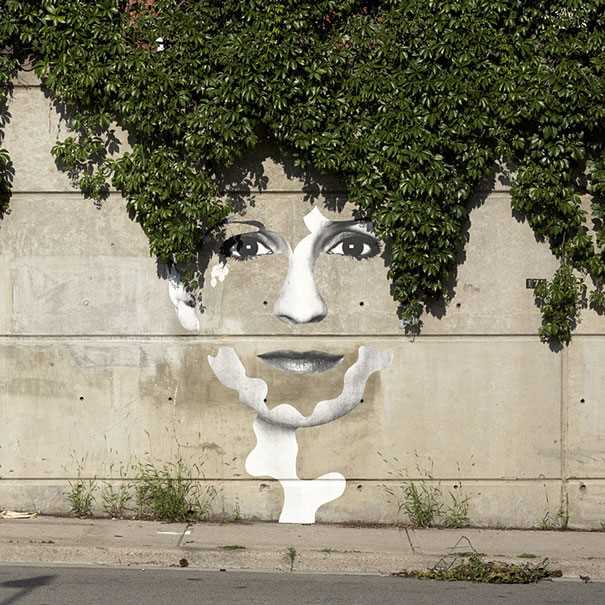
Street art has long been a form of expression and a powerful tool for political activism. Through graffiti, stencils, and murals, artists have used the public space to voice their concerns, challenge social norms, and advocate for change.
One of the main reasons street art has become a popular medium for political activism is its accessibility. Unlike traditional art galleries, street art is accessible to everyone, regardless of their social or economic background. It’s often found in public spaces such as walls, bridges, and sidewalks, where people can encounter it in their everyday lives.
Street art allows artists to address a wide range of political issues, from human rights and environmentalism to social injustice and government corruption. The art form provides a powerful platform for marginalized voices to be heard and for important social and political discussions to take place.
Through their art, street artists have the ability to raise awareness, provoke thought, and inspire action. Their messages can be simple yet impactful, using bold images and strong symbolism to convey their ideas. Street art has the power to challenge the status quo and disrupt the dominant narrative, making it a valuable tool for social and political change.
However, street art is not without its controversies. While some see it as an important form of dissent and a way to reclaim public spaces, others view it as vandalism and illegal. Governments and city authorities often crack down on street art, removing or painting over murals and prosecuting artists. This tension between artistic expression and public order adds another layer of complexity to the relationship between street art and political activism.
Despite the challenges, street art continues to thrive as a form of political activism. It not only provides a canvas for artists to express their ideas but also encourages public engagement and dialogue. Street art has the power to challenge dominant narratives, disrupt the status quo, and inspire social and political change.
Impact of Street Art on Communities
One of the most significant impacts of street art is its ability to engage and inspire community members. It provides a platform for self-expression, allowing artists to address social and political issues and spark important conversations. Through their artwork, street artists can challenge the status quo and raise awareness about various causes.
Street art also has the potential to boost tourism and revitalize local economies. Vibrant and visually appealing murals attract visitors, who then spend money in local businesses such as cafes, shops, and galleries. This can help create jobs and support the growth of small businesses.
Moreover, street art has the power to transform neglected and abandoned spaces into vibrant art galleries. By beautifying public spaces, it can deter crime and antisocial behavior, making communities safer and more inviting. It also contributes to the overall aesthetic appeal of a neighborhood, making it a more desirable place to live and visit.
Additionally, street art can foster a sense of pride and ownership among community members. When individuals see their neighborhoods represented in artwork, it can create a sense of attachment and connection. People feel a sense of belonging and identification with their community, which can lead to increased civic engagement and a stronger sense of community unity.
| Impact of Street Art on Communities |
|---|
| Social and cultural transformation |
| Engagement and inspiration |
| Economic benefits |
| Beautification and crime reduction |
| Sense of pride and ownership |
Street Art Festivals and Events
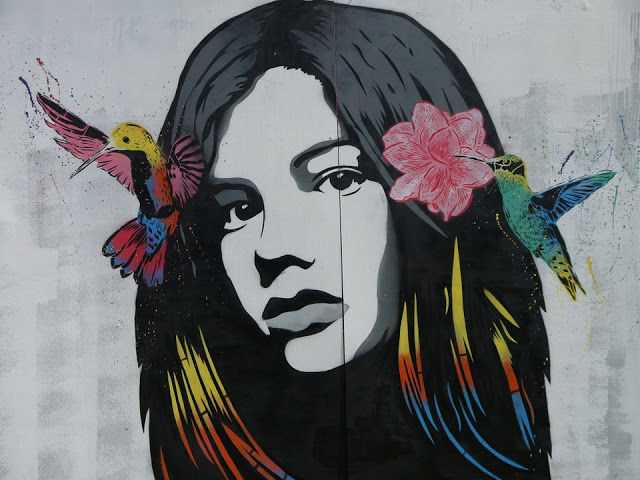
Street art festivals and events are becoming increasingly popular around the world, providing a platform for artists to showcase their creations in a public space. These festivals bring together street artists, local communities, and art enthusiasts to celebrate the vibrant and dynamic form of art.
One of the most renowned street art festivals is the Urban Art Festival held annually in Berlin, Germany. This event attracts artists from all over the world who transform the urban landscape with their imaginative and thought-provoking pieces. The festival features live art demonstrations, exhibitions, and interactive workshops, allowing attendees to actively engage with the artists and their work.
Street Art Events as a Catalyst for Urban Transformation

Street art festivals and events not only serve as a platform for artists but also act as a catalyst for urban transformation. By filling once neglected and abandoned spaces with art, these events rejuvenate the urban landscape and create a sense of community ownership. The presence of vibrant and thought-provoking artworks can also attract tourism and drive economic growth in the area.
Moreover, street art events often involve collaboration between artists and local communities. Artists may engage with the community to understand their needs and aspirations, and then create artwork that reflects their values and identity. This collaborative process fosters a sense of pride and connection within the neighborhood.
The Future of Street Art Festivals

As street art gains recognition as a legitimate form of artistic expression, the future of street art festivals looks promising. These events provide a platform for artists to showcase their talent, raise awareness about important social issues, and create meaningful connections with the community.
The increasing popularity of street art festivals has led to the emergence of new events around the world. From small local gatherings to large-scale international festivals, there is an ever-growing appreciation for this unique art form. With the continued support and recognition, street art festivals will continue to inspire and bring communities together through the power of creativity.
Preserving Street Art

Street art is a vibrant and dynamic form of artistic expression that adds beauty and character to urban landscapes. However, due to its ephemeral nature, street art is often at risk of being removed or destroyed. Preserving street art is therefore crucial to ensure its longevity and cultural significance.
Documentation

One way to preserve street art is through documentation. Taking high-quality photographs of street art can capture its essence and allow it to be enjoyed even after it has been removed or painted over. These photographs can be shared on social media platforms and websites dedicated to street art, creating a digital archive of this art form.
Legal Protection

Another important aspect of preserving street art is securing legal protection. Collaborating with local authorities and community organizations can help in designating certain areas as legal spaces for street art. By obtaining the necessary permits and permissions, street artists can create their art without the fear of it being removed or destroyed, and it can be preserved for future audiences to appreciate.
Additionally, establishing clear guidelines for preserving street art can help in preserving its integrity. Art preservation experts and conservationists can be consulted to ensure that the artwork is properly maintained and protected from environmental factors and vandalism.
Community Engagement

Engaging with the community is also vital in the preservation of street art. Encouraging local residents and visitors to respect street art and understand its importance can help prevent vandalism and damage. Organizing guided tours, workshops, and exhibitions can foster a sense of appreciation and encourage dialogue about street art, fostering a deeper understanding and connection to the art form within the community.
Preserving street art is essential not only for the art itself but also for the stories it tells and the cultural significance it holds. By documenting, protecting legally, and engaging with the community, street art can be preserved for future generations to enjoy and appreciate.

I am a mural enthusiast and a fervent admirer of street art. Rather than creating murals myself, I am passionate about collecting them. My love for street art knows no bounds. I am dedicated to curating and cherishing these artworks that grace the streets. My collection stands as a testament to my profound appreciation for this form of artistic expression.
read about me



